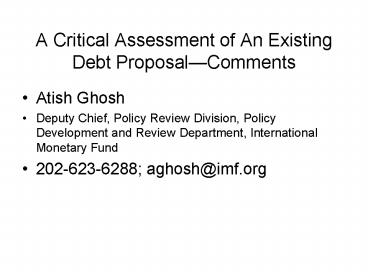A Critical Assessment of An Existing Debt ProposalComments PowerPoint PPT Presentation
1 / 21
Title: A Critical Assessment of An Existing Debt ProposalComments
1
A Critical Assessment of An Existing Debt
ProposalComments
- Atish Ghosh
- Deputy Chief, Policy Review Division, Policy
Development and Review Department, International
Monetary Fund - 202-623-6288 aghosh_at_imf.org
2
NPV of Debt for 27 Decision Point Countries
(Billions of US, 2002 NPV)
3
Poverty-Reducing Expenditures and Debt Service in
27 Decision Point Countries
4
Gross Flows of Official External Resources to 27
Decision Point Countries (in billions of US)
5
Net Flows of Official External Resources to 27
Decision Point Countries (billions of US,
percent of GDP)
6
Topical Issue
- As low-income countries reach Decision and
eventually Completion Points under HIPC, need a
prudent borrowing strategy going forward. - Future lending by the international community
should be geared to the countrys capacity to
carry debt. If more resources are required (e.g.
to help reach MDGs), these should be in the form
of grantsnot lending that leads to an
unsustainable debt burden.
7
Getting it Right is Important
- The Challenge Helping low-income countries
achieve their development goalse.g. MDGswhile
avoiding excessive debt burdens that stifle
growth or require socially costly cuts of
expenditure in the future. - Too permissive Future debt-servicing problems
that may be very costly in terms of development
goals. - Too conservative Deny resource transfer that
could otherwise have been used productively.
8
Work in Progress
- IMF and World Banktogether with various
stakeholdersworking on formulating a framework
that can help inform low-income countries on how
much they should prudently borrow, and how much
the BWIs should prudently lend. - Workshops (Paris, Berlin, Accra, Washington)
report to Boards in early 2004 with an
operational framework.
9
What is Debt Sustainability?
- Two concepts
- SolvencyThe present value of surpluses that the
country (or government) must (eventually)
generate equals the present value of its debt. - LiquidityRegardless of solvency, a country (or
government) may be illiquid if its available
financing and liquid assets are insufficient to
meet its current expenses and maturing
obligations. - In practice, concepts are blurred.
10
What is Debt Sustainability (cont.)?
- For market borrowers, liquidity is usually the
most important concept because they face
roll-over risk. - For low-income countries, solvency is usually the
more critical concept, because they borrow from
official lenders who would be more willing to
roll over debt (as long as solvency is
fulfilled)though they need to guard against
defensive lending.
11
Elements of a Framework
- Take account of country circumstances
- Current levels of debt (post-relief, as
applicable) - Policies and institutional capacity
- Realistic prospects for growth and exports
- Vulnerability to shocks
- Although HIPC was based on a uniform threshold
(for reasons of equity and transparency),
individual borrowing strategies for countries
should be geared to country specific
circumstances.
12
Methodology
- Project debt and debt-service indicators for a
given path of deficits and assumed grants. - Assess whether, given both cross-country evidence
and the countrys specific circumstances, the
projected debt and debt-service burdens become
excessive - Apply systematic stress testing to the
projections. - If baseline or adverse scenario debt dynamics
problematic, need to narrow deficits or seek more
grant financing.
13
Some Thresholds
14
Practical Problems and Issues
- Which indicators? Numerator Nominal vs. NPV
External debt, public external debt, total public
debt debt stock or debt service? - Denominator GDP, exports (remittances?), fiscal
revenues? - Total public or only public external? HIPC
public external (international community cannot
forgive debt that is owed to someone else!) But
solvency of the public sector depends on total
public debt. Data problems different terms,
track separately? - Balance of payments gaps vs. budget gaps--the
transfer problem (Keynes)either or both
constraints may be binding.
15
Practical Problems and Issues (cont.)
- Use projections or current ratios? (Long
maturityslow build up of debt problemsneed
projections but over-optimism of projections) - How to establish threshold values? Empirical
studiesproblems of interpretation (e.g. are
reschedulings indication of debt distress or a
form of transfer from the international
community)? Inherent limitationsType I and Type
II errors. - How to combine indicators? Factor analysis?
Interpretation? Binding constraint?
16
Practical Problems and Issues (cont.)
- Stress testing Too extremewould not want to
tailor borrowing strategy to them. Too benignmay
miss important risks.
17
Specifics of Issues Paper
- Use of nominal stock vs. NPV
- Need to work with NPVs (despite shortcomings)
because even concessional debts can have very
different terms, e.g. PRGF (5-10 yrs repayment)
vs. IDA (30-50 yrs repayment). - Inclusion of domestic debt
- Definitely want to track total public debt (data
problems!) but probably not aggregate (different
dynamics) - Focus on government debt/revenues and external
debt/exports - Look at various indicators, if one is out of
line, it might point to a problem with the
denominator (e.g. need to improve tax
administration)
18
Specifics of Issues Paper (cont.)
- Aggregate indicators using principal components
- Problems of interpretation
- Thresholds
- Country- and time-specific thresholdslimitations
of empirical work (what event is being modeled?
What is an acceptable probability of debt
distress?) - Split concessional loans into grant plus
non-concessional loan - Provide grants instead of loans to countries with
debt sustainability problemsbut ... it limits
the resource transfer to low-income countries.
19
Conclusions
- Various technical/methodological issues and
trade-offs. - Analytical framework can help inform judgments
about debt sustainability but cannot substitute
for such judgments. - But fair degree of concensus on basic approach
and the need to avoid a recurrence of debt
servicing problems. - Explore other ways to share riske.g. Hausmann
proposal or commodity price-linked debt service.
20
Conclusions
- Getting it right is important ...but not easy!
21
NPV of Debt of Countries that reached Completion
Point by mid-2003 (billions of US, 2002 NPV)

